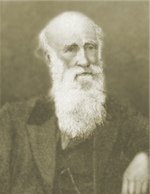John Thomas (Christadelphian)
| John Thomas | |
|---|---|

John Thomas (Christadelphian)
|
|
| Born |
April 12, 1805 Hoxton Square, Hackney, London. |
| Died | March 5, 1871 (aged 65) |
Dr. John Thomas (April 12, 1805 – March 5, 1871) was the founder of the Christadelphian movement, a Restorationist, with doctrines similar in part to some 16th-century Antitrinitarian Socinians and the 16th-century Swiss-German pacifist Anabaptists.
John Thomas M.D., born in Hoxton Square, Hackney, London, on April 12, 1805, was the son of a Dissenting minister, also named John Thomas. His family is reputed to be descended from French Huguenot refugees. His family moved frequently, as his father took up various pastorships including a congregation in London, a brief but eventful stay in northern Scotland, back to London, and then up to Chorley, Lancashire. John Thomas was a very disciplined student having taught himself Hebrew as a teenager. At the age of 16, in Chorley, he began studying medicine. His family moved back to London, but John Thomas stayed in Chorley. After two years, he returned to London to continue his studies at the Guy's and St. Thomas's hospitals for a further three years. He trained as a surgeon and had a keen interest in chemistry and biology, publishing several learned medical articles for The Lancet, one of which argued in favour of the importance of the use of corpses for the study of medicine (it was illegal in England to dissect them at this time).
Like many people of that era, in 1832 his father made the decision to seek fresh opportunities and emigrate to America. So it was that Dr John Thomas, having few ties, decided to go with his family, agreeing to go on ahead and prepare for the family. He took the opportunity to further his career and accepted an appointment as ship's surgeon on the Marquis of Wellesley which was bound from St Katharine Docks, London to New York.
The ship embarked on May 1, 1832 and immediately sailed into stormy weather that lasted the whole voyage. During one ferocious storm the ship lost the top of the main-mast and heavy seas stove in the bulwarks, washing everything moveable off the deck. The ship eventually ran into shallow water and ran aground off the coast of Nova Scotia. The ship was raised up by the waves on twelve successive occasions, each time the keel striking the sea bed with such force that both crew and passengers were convinced the ship would break up.
...
Wikipedia
